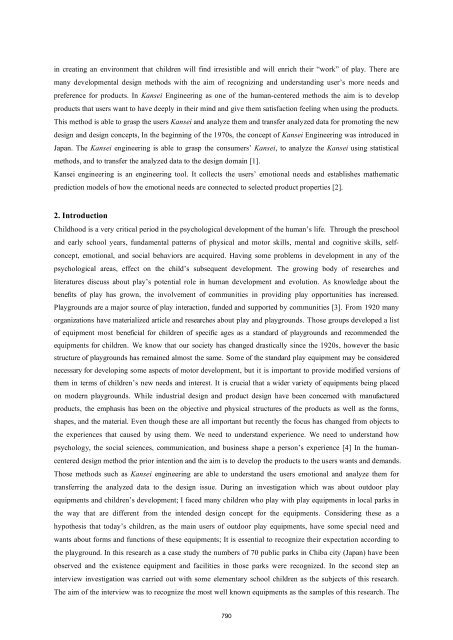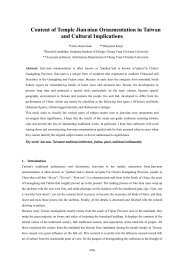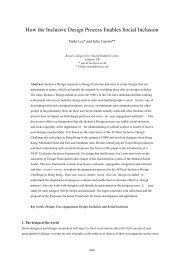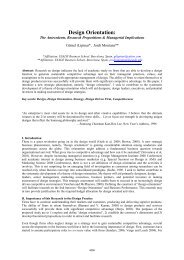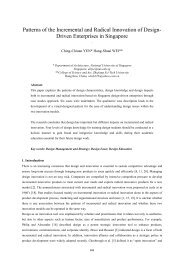Case study about a new design concept for public ... - iasdr 2009
Case study about a new design concept for public ... - iasdr 2009
Case study about a new design concept for public ... - iasdr 2009
Create successful ePaper yourself
Turn your PDF publications into a flip-book with our unique Google optimized e-Paper software.
in creating an environment that children will find irresistible and will enrich their “work” of play. There are<br />
many developmental <strong>design</strong> methods with the aim of recognizing and understanding user’s more needs and<br />
preference <strong>for</strong> products. In Kansei Engineering as one of the human-centered methods the aim is to develop<br />
products that users want to have deeply in their mind and give them satisfaction feeling when using the products.<br />
This method is able to grasp the users Kansei and analyze them and transfer analyzed data <strong>for</strong> promoting the <strong>new</strong><br />
<strong>design</strong> and <strong>design</strong> <strong>concept</strong>s, In the beginning of the 1970s, the <strong>concept</strong> of Kansei Engineering was introduced in<br />
Japan. The Kansei engineering is able to grasp the consumers’ Kansei, to analyze the Kansei using statistical<br />
methods, and to transfer the analyzed data to the <strong>design</strong> domain [1].<br />
Kansei engineering is an engineering tool. It collects the users’ emotional needs and establishes mathematic<br />
prediction models of how the emotional needs are connected to selected product properties [2].<br />
2. Introduction<br />
Childhood is a very critical period in the psychological development of the human’s life. Through the preschool<br />
and early school years, fundamental patterns of physical and motor skills, mental and cognitive skills, self-<br />
<strong>concept</strong>, emotional, and social behaviors are acquired. Having some problems in development in any of the<br />
psychological areas, effect on the child’s subsequent development. The growing body of researches and<br />
literatures discuss <strong>about</strong> play’s potential role in human development and evolution. As knowledge <strong>about</strong> the<br />
benefits of play has grown, the involvement of communities in providing play opportunities has increased.<br />
Playgrounds are a major source of play interaction, funded and supported by communities [3]. From 1920 many<br />
organizations have materialized article and researches <strong>about</strong> play and playgrounds. Those groups developed a list<br />
of equipment most beneficial <strong>for</strong> children of specific ages as a standard of playgrounds and recommended the<br />
equipments <strong>for</strong> children. We know that our society has changed drastically since the 1920s, however the basic<br />
structure of playgrounds has remained almost the same. Some of the standard play equipment may be considered<br />
necessary <strong>for</strong> developing some aspects of motor development, but it is important to provide modified versions of<br />
them in terms of children’s <strong>new</strong> needs and interest. It is crucial that a wider variety of equipments being placed<br />
on modern playgrounds. While industrial <strong>design</strong> and product <strong>design</strong> have been concerned with manufactured<br />
products, the emphasis has been on the objective and physical structures of the products as well as the <strong>for</strong>ms,<br />
shapes, and the material. Even though these are all important but recently the focus has changed from objects to<br />
the experiences that caused by using them. We need to understand experience. We need to understand how<br />
psychology, the social sciences, communication, and business shape a person’s experience [4] In the human-<br />
centered <strong>design</strong> method the prior intention and the aim is to develop the products to the users wants and demands.<br />
Those methods such as Kansei engineering are able to understand the users emotional and analyze them <strong>for</strong><br />
transferring the analyzed data to the <strong>design</strong> issue. During an investigation which was <strong>about</strong> outdoor play<br />
equipments and children’s development; I faced many children who play with play equipments in local parks in<br />
the way that are different from the intended <strong>design</strong> <strong>concept</strong> <strong>for</strong> the equipments. Considering these as a<br />
hypothesis that today’s children, as the main users of outdoor play equipments, have some special need and<br />
wants <strong>about</strong> <strong>for</strong>ms and functions of these equipments; It is essential to recognize their expectation according to<br />
the playground. In this research as a case <strong>study</strong> the numbers of 70 <strong>public</strong> parks in Chiba city (Japan) have been<br />
observed and the existence equipment and facilities in those parks were recognized. In the second step an<br />
interview investigation was carried out with some elementary school children as the subjects of this research.<br />
The aim of the interview was to recognize the most well known equipments as the samples of this research. The<br />
790


